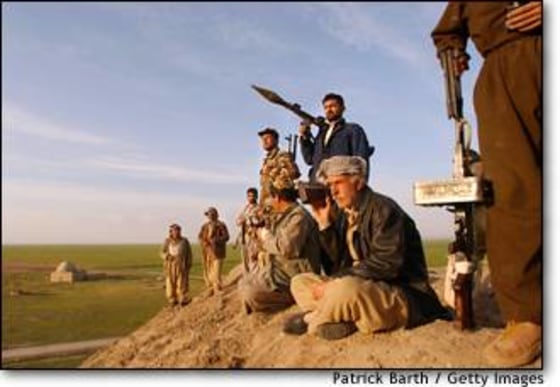On a deserted hilltop overlooking the nighttime glow of Kirkuk’s oil refineries, a lone shepherd approaches with a warning: “You better leave now,” he says, startled by the presence of a reporter in the middle of the night. “Some Iraqi soldiers just came down from their bunkers and stole two of my sheep. They are hungry and angry.”
After two weeks of heavy U.S. bombing on the front lines separating Iraqi troops and Kurdish opposition forces in northern Iraq, it’s now possible to get within 10 miles of Kirkuk, whose oil resources will be key to rebuilding postwar Iraq.
Seen from the well-worn smuggler’s routes used to skirt U.N. sanctions with contraband gasoline, one of Kirkuk’s oil refineries blazes before the city’s shimmering lights.
The silence is broken by the clanging of bells hung around the necks of the shepherd’s sheep.
The 200-mile front line separating the Kurds from Iraqi forces had barely moved in years. Much of the line is under the 36th parallel and outside the scope of the “no-fly” zone patrolled by American and British aircraft.
But in the last two weeks of U.S. bombing, the Kurds, an Iraqi minority long persecuted by Iraqi President Saddam Hussein, have regained vast tracts of land from the Iraqi ruler’s regime. They have hardly fired a shot.
The some 50,000 residents of Chamchamal, a Kurdish town perched on the front line, lived for years under the threat of Iraqi soldiers and their lethal mortars. After a round of intense U.S. bombings, the Iraqi forces have melted away.
Eighty miles south of Chamchamal, in the village of Kifrey, children used to play soccer on a field that backed onto a small hilltop that served as an Iraqi bunker position. A mine field separated the cheers of the daily games and the Iraqi fortress. The mines are still there, but the Iraqi troops are not.
REDISCOVERED PAST
As the Kurds emerge from the constant threat of Saddam’s forces, they are also rediscovering their past. The town of Qadir Karim had been under Saddam’s control since 1985, when the Iraqi leader “Arabized” the region, forcing Kurds from the town and surrounding villages. Many of the Kurdish inhabitants were expelled to a “collective town” and their villages razed.
Today in Qadir Karim, revenge is in the air. A mural of Saddam, a fixture in all Iraqi towns, has been covered with blood-red paint.
Some of Saddam’s largest expulsions were in Kirkuk, where 120,000 Kurds were driven from their homes. Many settled in Chamchamal, where men gather every day in the market, plotting their return. Swathed in Kurdish tribal colors and clutching an assortment of weapons, including rocket-propelled grenades, they are nearly indistinguishable from the peshmergas, the Kurdish opposition forces.
As civilians, the men say they are waiting to return to Kirkuk, the Kurdish ancestral capital, to reclaim land and property that Saddam’s henchmen expropriated from them.
In the Chamchamal bazaar, Ahmed, 22, shifts his AK-47 machine gun from hand to hand.
“They stole my father’s house and store,” he says. “I just want to get back what belongs to our family.” As he speaks, a U.S. plane bombs an Iraqi position on the hill above Chamchamal.
Though their resistance has been limited, the Iraqi troops occasionally fire back — but not at the Americans. Civilians pushing toward Kirkuk have been shelled by the retreating Iraqi forces.
The oil installations needed to fund Iraq’s future have also suffered in the retreat. Kurds says one oil facility’s control room was gutted and equipment was ripped from the floor, leaving a mangle of wires sprouting out.
“We are here to protect this area, but the Iraqis took all the equipment we need to operate this facility,” said Ekram, a Kurd displaced by Saddam.
(NBC producer Babak Behnam is on assignment in Iraq.)
